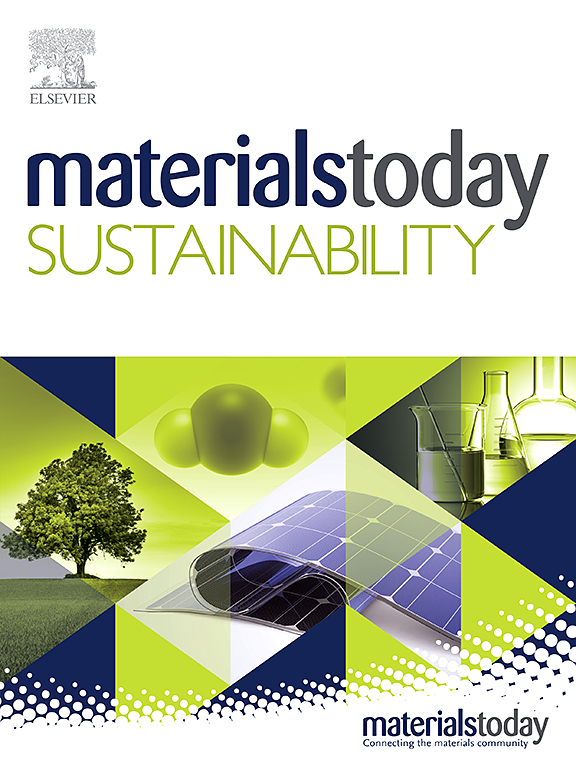Development and validation of eco-friendly designed heat and moisture exchange filters for the safeguard of the respiratory tract and of the environment
IF 7.1
3区 材料科学
Q1 GREEN & SUSTAINABLE SCIENCE & TECHNOLOGY
引用次数: 0
Abstract
For many years, Heat and Moisture Exchange (HME) filters have been used for the safeguard of hospitalized patients subjected to long-term mechanical ventilation, anaesthesia, or intensive care. These devices, also namely “artificial noses”, are essential to maintain normal levels of humidity, warmth, and decontamination of the trachea when the upper airways are bypassed and in general when patients are subjected to ventilation with technical gases. Their function is to retain and reuse part of the heat and the moisture captured from the exhaled air, to precondition the inhaled technical gas. The currently used HME devices still have some limitations concerning above all the costs of raw materials and processes as well as their environmental impact. Further, this study aims to develop and validate eco-friendly and biodegradable HME filters developed through a green manufacturing process and reusing raw materials deriving from food waste to reduce their environmental impact. In detail, an extremely porous aerogel has been developed by exploiting the chemical advantages offered by biopolymers, like gelatin and chitosan, and designed with a view of attempt selection of raw materials and of process parameters for the obtaining of highly efficient devices, but while maintaining a low costs attractive to the market of disposable devices such as HME. Between the process parameters, freeze-drying and cross-linking steps were managed to achieve the target of low cost and time savings, making the process more easily scalable at industrial level, and improving the HME efficiency. Pressure drops, moisture and heat transfer, microbial filtration efficiency and bacteriostatic capacity of the HME filters were validated, both in vitro and in a hospital environment, also highlighting the device's ability to capture bacterial and inhibit their proliferation, a key feature for the preservation of patent health and of clinical instruments as well as for the possibility of being marketed. Further, it was achieved a proof of concept on the inclusion of a diagnostic tool in the HME structure. It can provoke the colour changing of the device in the presence of bacteria. This would make it easier to de-hospitalize patients, reducing healthcare costs but keeping their health status constantly monitored outside the hospital.

开发和验证环保设计的热和湿气交换过滤器,以保护呼吸道和环境
多年来,热湿交换(HME)过滤器已被用于长期机械通气,麻醉或重症监护的住院患者的保障。这些装置,也被称为“人工鼻子”,对于维持正常的湿度、温度和在绕过上呼吸道时以及通常在病人接受技术气体通气时对气管进行净化是必不可少的。它们的功能是保留和再利用从呼出的空气中捕获的部分热量和水分,对吸入的技术气体进行预处理。目前使用的HME设备仍然有一些限制,首先是原材料和工艺的成本以及它们对环境的影响。此外,本研究旨在开发和验证通过绿色制造工艺和再利用来自食物垃圾的原材料开发的生态友好型和可生物降解的HME过滤器,以减少其对环境的影响。详细地说,通过利用生物聚合物如明胶和壳聚糖提供的化学优势,开发了一种极多孔气凝胶,并以尝试选择原材料和工艺参数的观点设计,以获得高效的设备,同时保持低成本,对一次性设备(如HME)市场具有吸引力。在工艺参数之间,冷冻干燥和交联步骤实现了低成本和节省时间的目标,使该工艺更容易在工业水平上扩展,并提高了HME效率。在体外和医院环境中验证了HME过滤器的压降、水分和热量传递、微生物过滤效率和抑菌能力,也强调了该设备捕获细菌并抑制其增殖的能力,这是保护专利健康和临床仪器以及上市可能性的关键特征。此外,它还实现了在HME结构中包含诊断工具的概念验证。在细菌存在的情况下,它会引起设备的颜色变化。这将使病人更容易出院,减少医疗保健费用,但保持他们的健康状况在医院外的持续监测。
本文章由计算机程序翻译,如有差异,请以英文原文为准。
求助全文
约1分钟内获得全文
求助全文
来源期刊

Materials Today Sustainability
Multiple-
CiteScore
5.80
自引率
6.40%
发文量
174
审稿时长
32 days
期刊介绍:
Materials Today Sustainability is a multi-disciplinary journal covering all aspects of sustainability through materials science.
With a rapidly increasing population with growing demands, materials science has emerged as a critical discipline toward protecting of the environment and ensuring the long term survival of future generations.
 求助内容:
求助内容: 应助结果提醒方式:
应助结果提醒方式:


